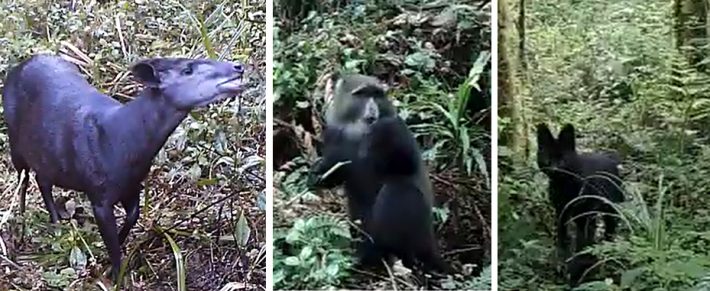Rare antelopes and black cats
University of Würzburg press release.
Rare Abbott ducker antelope and other elusive large mammals on Kilimanjaro have been documented using video traps in research published in Journal of Animal Ecology.

A Würzburg research group has documented numerous large mammals on Kilimanjaro with video traps. The protected areas of the mountain are enormously important for the biodiversity of this animal group.
Tanzania is home to a very shy antelope species that cannot be found anywhere else in the world. According to the Red List, it can be classified as endangered. Only in the year 2003 researchers succeeded in taking a photo of one of these antelopes for the first time. How often it occurs at Kilimanjaro has not been documented so far. Its name: Abbott ducker (Cephalophus spadix).
But now there are numerous videos in which the antelopes can be seen. The film sequences were taken by a research group of Julius-Maximilians-Universität (JMU) Würzburg in Bavaria, Germany. The group has been researching biodiversity at Kilimanjaro for years. Current research has focused, among other things, on the question of how the biodiversity of larger mammals is influenced by climate change and human activities.
“We caught the Abbott ducker a total of 105 times with our video traps at eleven locations at altitudes between 1920 and 3849 meters,”
says doctoral student Friederike Gebert from the JMU Biocenter. “There’s even a video of a mating attempt,” says the scientist. And that’s not the only special feature that has now been captured on film.
Tens of thousands of video sequences evaluated
The team led by JMU Professor Ingolf Steffan-Dewenter and Dr. Marcell Peters had installed a total of five camera traps each on 66 study areas at Kilimanjaro – from the savannah in the lowlands to the forest regions at medium altitudes to the bush landscape at altitudes of up to 4550 metres. The cameras remained on site for two weeks, after which they were collected and evaluated.
Friederike Gebert had 80,000 film snippets to view, of which 1,600 were actually mammals. Among them were a total of 33 wild animal species – in addition to the Abbott ducker, for example bush and porcupine pigs, small kudus or steppe baboons. Serval cats are also documented. These yellow-black patterned predators are about the size of lynxes, but more daintily built. The videos also show a very special Serval variant: an animal whose coat is completely black.
Protected areas are important for biodiversity
The results of the JMU research group are published in the Journal of Animal Ecology.
“All in all, we were able to show that the species richness is greatest in large mammals in the middle heights of the mountain, i.e. in the forest regions,”
says Friederike Gebert. The more plant biomass and potential prey there are, the greater the biodiversity.
“In the case of large mammals, biodiversity is particularly high in nature reserves, while it falls by 53 percent in unprotected areas – even though many of the unprotected areas still have natural vegetation,” says Professor Steffan-Dewenter. “Our study thus underscores the importance of protected areas for maintaining species diversity in large mammals in tropical mountain regions. To preserve the protected areas at Kilimanjaro and to designate further ones is a very desirable goal from the scientific point of view.
Cooperation partners and sponsors
This publication is the result of a cooperation between the University of Würzburg, the Nelson Mandela African Institution of Science and Technology (Arusha, Tanzania), and the College of African Wildlife Management (Mweka, Tanzania).
The German Research Foundation (DFG) has funded the work as part of the DFG Research Group 1246 (Kilimanjaro Ecosystems Under Global Change: Linking biodiversity, biotic interactions and biogeochemical ecosystem processes – speaker: Prof. Dr. Ingolf Steffan-Dewenter). Financial support was also provided by the German Academic Exchange Service (DAAD).
Read full study (free to read for a limited time):
Gebert F, Njovu HK, Treydte AC, Steffan-Dewenter I, Peters MK. Primary productivity and habitat protection predict elevational species richness and community biomass of large mammals on Mt. Kilimanjaro. Journal of Animal Ecology. DOI: 10.1111/1365-2656.13074
Media Contact:
Friederike Gebert, Biocenter, Chair of Zoology III (Animal Ecology and Tropical Biology), University of Würzburg, T +49 931 31-81997, friederike.gebert@uni-wuerzburg.de
Weblinks
Report about the Kilimanjaro research in Würzburg in “The Scientist”
Website of the DFG Research Group Kilimanjaro
Like what we stand for?
Support our mission and help develop the next generation of ecologists by donating to the British Ecological Society.